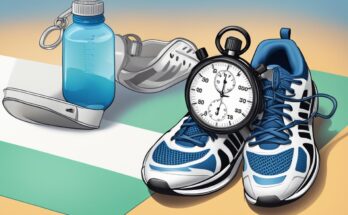Trail running is an exhilarating and challenging outdoor activity that has been gaining popularity in recent years. It involves running on natural trails, often in scenic and remote areas, and can provide a unique and rewarding experience for those who enjoy being in nature. However, starting trail running can be intimidating for those who are used to running on roads or tracks.
To begin trail running, it is important to have the right gear and equipment. This includes trail running shoes with good grip and support, as well as appropriate clothing for the weather conditions and terrain. It is also recommended to bring a hydration system, such as a water bottle or hydration pack, as well as a map or GPS device to navigate the trails.
When starting out, it is important to choose a trail that matches your fitness level and experience. It is also recommended to start with shorter distances and gradually increase the length and difficulty of the trails over time. Proper warm-up and cool-down routines, as well as stretching and strength training exercises, can also help prevent injuries and improve performance. With the right preparation and mindset, trail running can be a fulfilling and enjoyable activity for anyone looking to explore the great outdoors.
Basics of Trail Running
Understanding Trail Running
Trail running involves running on unpaved paths, typically through natural environments such as forests, mountains, or deserts. Unlike road running, trail running can be more challenging due to the uneven terrain, elevation changes, and obstacles such as rocks, roots, and streams. Trail running can be done solo or with a group, and there are often organized trail races for those looking for a competitive challenge.
Benefits of Trail Running
Trail running offers numerous benefits for both physical and mental health. Here are some of the benefits of trail running:
- Physical Health: Trail running provides a full-body workout, engaging muscles that may not be used in road running. The uneven terrain and elevation changes can increase strength and endurance, while also improving balance and coordination. Trail running can also be gentler on the joints, as the softer surface can reduce impact.
- Mental Health: Trail running can have a positive impact on mental health by reducing stress and anxiety. Being in nature and away from the hustle and bustle of daily life can be calming and restorative. Trail running can also provide a sense of adventure and accomplishment, boosting confidence and self-esteem.
- More Challenge: Trail running can be more challenging than road running, providing an opportunity to push oneself and set new goals. The changing terrain and obstacles can require mental focus and problem-solving skills, making trail running a mentally stimulating activity.
In summary, trail running is a great way to connect with nature, challenge oneself, and improve both physical and mental health.
Getting Started with Trail Running
Choosing the Right Terrain
Trail running can be a great way to enjoy nature while getting a workout. However, it is important to choose the right terrain to avoid injury. Local trails, forest trails, dirt paths, gravel roads, footpaths, and bike paths are all great options for trail running. When choosing a trail, it is important to consider the terrain, elevation, and distance.
For beginners, it is recommended to start with flat or gently rolling terrain. This will help build endurance and prevent injury. Once comfortable with the terrain, runners can gradually increase the difficulty of the trail. It is also important to wear appropriate shoes for the terrain. Trail running shoes with good traction and support are recommended.
Starting Slowly
When starting trail running, it is important to start slowly. This means starting with short distances and gradually increasing the distance over time. It is also important to take breaks as needed and listen to your body. Trail running can be more physically demanding than running on pavement, so it is important to allow your body time to adjust.
It is also recommended to start with a run/walk approach. This means alternating between running and walking to build endurance and prevent injury. A good starting point is to run for one minute and walk for one minute. Gradually increase the running time and decrease the walking time as endurance improves.
In conclusion, trail running can be a great way to enjoy nature while getting a workout. When starting trail running, it is important to choose the right terrain and start slowly to prevent injury. By following these tips, beginners can build endurance and enjoy the benefits of trail running.
Essential Gear for Trail Running
Trail running requires specific gear to ensure a safe and enjoyable experience. Here are some essential items to consider when gearing up for your next trail run.
Choosing the Right Shoes
The most important gear for trail running is a good pair of trail running shoes. These shoes are designed to provide better traction and stability on uneven terrain. When shopping for trail running shoes, consider the following factors:
- Traction: Look for shoes with lugged soles that provide good traction on dirt, rocks, and other natural surfaces.
- Stability: Trail running shoes should have a sturdy sole and a supportive upper to help prevent ankle sprains and other injuries.
- Fit: Make sure the shoes fit well and are comfortable, with enough room in the toe box to allow for natural foot movement.
Dressing for the Weather
Trail runners should dress appropriately for the weather conditions. Quick-drying fabrics are ideal for wicking away sweat and preventing chafing. Consider the following clothing items:
- Running jacket: A lightweight, waterproof jacket can protect against wind and rain.
- Gloves: Gloves can keep hands warm in cold weather and protect against scratches and cuts from branches and rocks.
- Moisture-wicking fabrics: These fabrics help keep the body cool and dry in hot weather.
Hydration Packs and Water Bottles
Staying hydrated is crucial during trail running. Hydration packs and water bottles are essential gear for carrying water and other fluids. Consider the following options:
- Hydration packs: These backpacks have a built-in water bladder and a tube for easy drinking while on the go.
- Handheld water bottles: These bottles are carried in the hand and are ideal for shorter runs.
- Water bottle: A standard water bottle can be carried in a backpack or waist belt.
Navigation Tools and Safety Gear
Trail runners should always carry navigation tools and safety gear in case of emergencies. Consider the following items:
- Map and compass: These tools can help navigate unfamiliar trails.
- GPS device: A GPS can help track distance, speed, and location.
- First aid kit: A basic first aid kit can help treat minor injuries.
- Headlamp: A headlamp can help navigate trails in low-light conditions.
- Whistle: A whistle can be used to signal for help in case of an emergency.
By considering these essential gear items, trail runners can ensure a safe and enjoyable experience on the trails.
Training and Techniques for Trail Running
Running Form and Pacing
Proper trail running form is essential for avoiding injuries and maximizing performance. Trail runners should maintain an upright posture, engage their core muscles, and keep their arms relaxed at their sides. They should also take shorter strides and lift their feet higher to avoid tripping on rocks and roots.
Pacing is another critical component of trail running. Runners should start at a comfortable pace and gradually increase their speed as they become more comfortable on the trail. They should also be mindful of their breathing and adjust their pace accordingly.
Dealing with Natural Obstacles
Trail runners must be prepared to encounter a variety of natural obstacles, including rocks, roots, and fallen trees. To navigate these obstacles safely, runners should keep their eyes focused on the trail ahead and adjust their stride and pace as necessary. They should also be prepared to jump or step over obstacles when necessary.
Uphill and Downhill Running
Uphill running requires a combination of strength, coordination, and endurance. To tackle steep inclines, runners should lean forward slightly and take shorter, quicker steps. They should also engage their core muscles and use their arms to help propel themselves up the hill.
Downhill running can be even more challenging, as runners must navigate steep descents while maintaining their balance and control. To run downhill safely, runners should lean back slightly and take longer, slower strides. They should also keep their eyes focused on the trail ahead and adjust their pace as necessary.
Overall, trail running requires a combination of physical and mental strength, coordination, and endurance. By practicing proper form, pacing, and technique, runners can improve their performance and minimize their risk of injury on the trail.
Health and Nutrition for Trail Runners
Hydration and Nutrition
Staying hydrated and fueling properly is crucial for trail runners. During long runs, the body loses a lot of fluids and electrolytes, which need to be replenished. It is recommended to drink water every 15-20 minutes during a run, and to also consume an electrolyte drink or tablet to replace lost minerals.
In terms of nutrition, it is important to eat a balanced diet that includes carbohydrates, protein, and healthy fats. Carbohydrates provide the body with energy, while protein helps repair and build muscles. Healthy fats are important for joint health and maintaining a healthy weight.
During long runs, it is recommended to consume energy gels or chews to maintain energy levels. It is important to find a brand and flavor that works for you, as some people may experience stomach discomfort with certain products.
Rest and Recovery
Rest days are just as important as training days for trail runners. Rest allows the body to recover and repair muscles, reducing the risk of injury. It is recommended to take at least one or two rest days per week, depending on the intensity of training.
In addition to rest days, recovery practices such as stretching, foam rolling, and massage can help reduce soreness and improve flexibility. Adequate sleep is also important for recovery, as it allows the body to repair and regenerate cells.
Overall, trail runners should prioritize their health and nutrition to ensure they can perform at their best. By staying hydrated, fueling properly, and allowing for rest and recovery, runners can reduce the risk of injury and improve their overall performance.
Advanced Trail Running Tips
Understanding Different Types of Trails
Advanced trail runners understand that different types of trails require different approaches. For example, running on rocky and technical terrain requires more focus and attention to foot placement, while running on smooth and even terrain allows for a faster pace. It’s important to research the trail you plan to run on and understand its features before heading out. This will help you prepare mentally and physically for the challenges ahead.
Running in Different Weather Conditions
Trail running can be unpredictable, and weather conditions can change quickly. Advanced trail runners know how to adapt to different weather conditions. For example, running in hot and humid weather requires staying hydrated and taking breaks in the shade. Running in cold and wet weather requires wearing appropriate gear and being mindful of slippery terrain. It’s important to check the weather forecast before heading out and to bring extra gear as needed.
Improving Balance and Stability
Trail running often involves running on uneven and varied terrain, which requires good balance and stability. Advanced trail runners know how to improve their balance and stability through specific exercises, such as single-leg squats and balance drills. They also use trail running as an opportunity to practice balance and stability on the trail itself. It’s important to start with easy trails and gradually work up to more challenging terrain.
Overall, advanced trail running requires a combination of physical and mental preparation, as well as a willingness to adapt to different types of trails and weather conditions. By understanding the terrain, being mindful of weather conditions, and improving balance and stability, trail runners can take their skills to the next level and enjoy the beauty and challenges of the trail.
Joining a Trail Running Community
Trail running is a great way to stay fit and enjoy the outdoors. However, it can be challenging to get started. One way to make it easier is by joining a trail running community. This section will explore two types of communities: Local Running Clubs and Online Running Communities.
Local Running Clubs
Local running clubs are a great way to meet other trail runners in your area. They often organize group runs, which can be a fun and social way to explore new trails. Here are a few tips for finding and joining a local running club:
- Check with your local running store. They may have information about local clubs.
- Search online for clubs in your area. Websites like Strava can also be helpful.
- Attend a local race or trail running event. You may meet club members there.
When joining a club, be sure to ask about their pace and distance requirements. Some clubs cater to beginners, while others are more advanced. It’s also a good idea to ask about their safety policies and any membership fees.
Online Running Communities
Online running communities can be a great resource for trail runners. They allow you to connect with other runners from all over the world, share tips and advice, and stay motivated. Here are a few popular online running communities:
- Strava: This social network for athletes allows you to track your runs, connect with other runners, and join virtual clubs.
- Reddit: The r/trailrunning subreddit is a great place to ask questions, share stories, and connect with other trail runners.
- Facebook Groups: There are many Facebook groups dedicated to trail running. Search for groups in your area or for specific topics like trail running gear or nutrition.
When joining an online community, be sure to read the rules and guidelines. Some communities have strict posting guidelines or require you to be active to remain a member.
By joining a trail running community, you can learn from others, explore new trails, and stay motivated. Whether you prefer local running clubs or online communities, there are many options to choose from.
Conclusion
Trail running can be a great way to explore the outdoors, challenge yourself, and improve your fitness. It is important to have the right gear essentials, such as trail running shoes and a hydration system, and to dress in layers to accommodate changing weather conditions.
Beginner runners may want to start with shorter distances and gradually increase their duration and distance as their fitness level improves. It is also important to be aware of the surface and terrain, as off-road running can be more challenging on the joints and muscles than running on paved surfaces.
Trail running can provide beautiful scenery and opportunities to see wildlife, but it is important to be aware of any potentially poisonous plants in the area. Navigation tools, such as a trail map or GPS, can help ensure a safe and enjoyable experience.
Having better traction on the trails can also be important, especially when encountering steep or slippery terrain. Trail running shoes with good traction can help provide this.
Overall, trail running can be a rewarding and adventurous activity for those who are confident and knowledgeable about the sport. With the right preparation and gear, anyone can enjoy the benefits of trail running.




